A 1-day group tour in NW Norfolk. The weather felt more like winter at times – mostly cloudy with intermittent rain showers, a maximum of 10C, and an increasingly blustery wind through the afternoon. Despite all that, we had a very nice day out and saw a good selection of spring migrants.
Our first destination for the morning was Snettisham Coastal Park. As we got out of the minibus, we could hear a Lesser Whitethroat singing and as we walked in through the bushes we heard another one which showed itself a couple of times in the hawthorns. This is always a good site for spring warblers, but it seemed a little quiet today – perhaps the cold weather was suppressing activity and some birds are later to arrive this year. There were plenty of Chiffchaffs in and singing and we heard a brief snatch from a Willow Warbler. A Marsh Harrier drifted over the bushes.
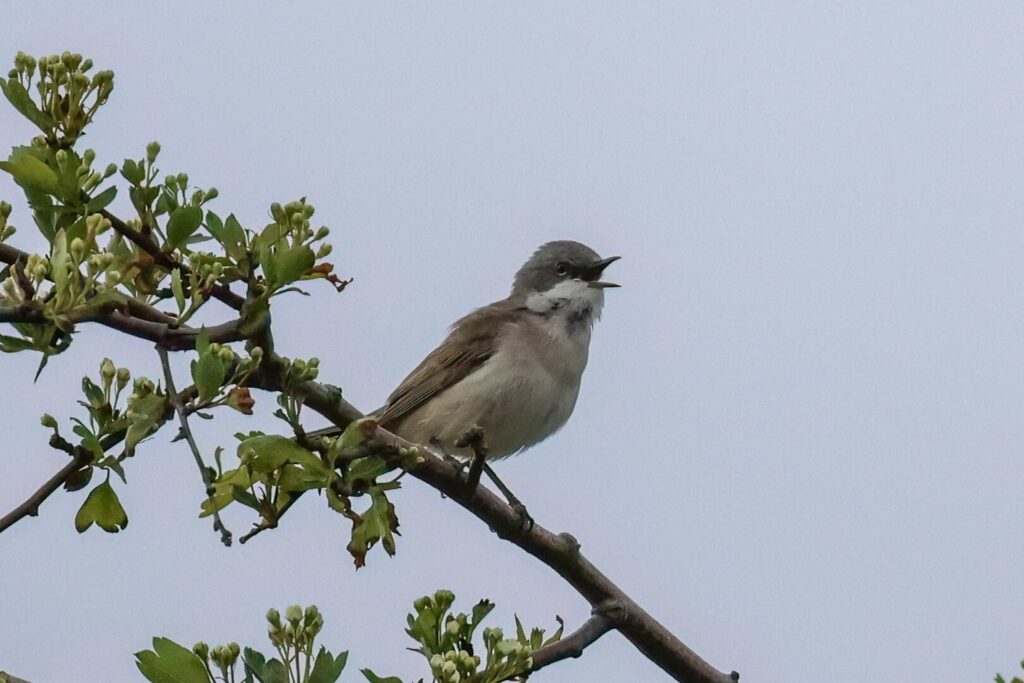
Cutting across on the path through the reeds, we found a few more warblers. A couple of Sedge Warblers were singing and songflighting but mostly keeping tucked down in the vegetation this morning. We heard a Common Whitethroat singing in the bushes over the far side too and had a couple of brief views of it in the tops of the hawthorns.

Back out into the open area there were several Linnets feeding on the short grass as we cut across and up onto the outer seawall. The tide was just going out and there were small groups of waders feeding on the exposed mud – several Bar-tailed Godwits in the water, several moulting into brighter rusty breeding plumage, and lots of Oystercatchers on the shore, with more Knot, Grey Plover, Dunlin and one or two Turnstones on the exposed mud.
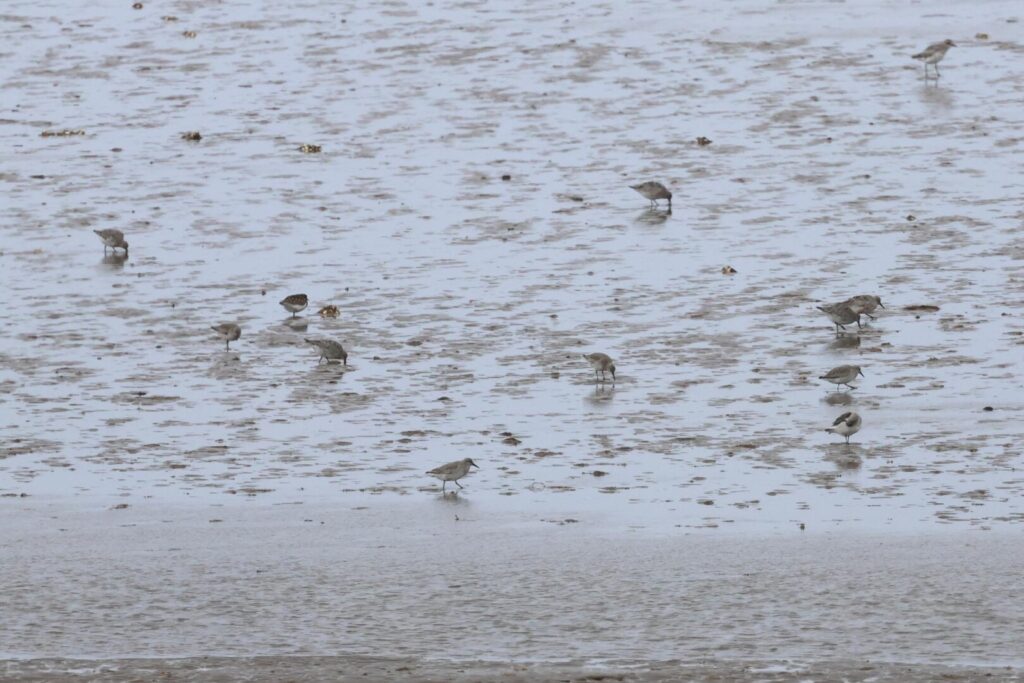
We walked a short way up along the top of the seawall. A Swallow flew past, heading south, and shortly after what may have been the same one came back the other way out over the mud. A couple of Meadow Pipits were singing, fluttering up before parachuting down with their tails raised, landing on the rope around the beach cordons. Another Common Whitethroat flicked ahead of us and there were two or three pairs of Stonechats in the bushes.
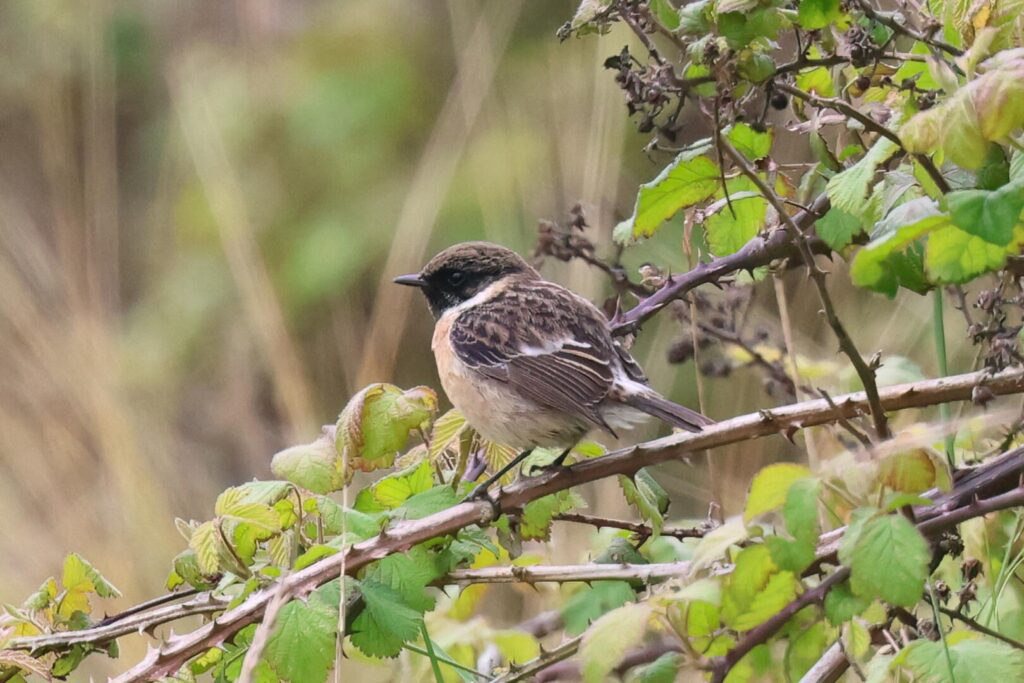
Looking across to Ken Hill Marshes, beyond the inner seawall, we could see a few geese around the pools – Greylags and Canada Geese and a single Pink-footed Goose with them. Most of the Pinkfeet that spent the winter here have long since departed, back to Iceland for the breeding season, but a small number are usually left behind, often birds which had been shot and winged and are now unable to make the journey. A couple of Mediterranean Gulls flew over flashing their white wingtips as a pair of Pintail circled up.
We cut down into the middle, where we would be out of the wind, and found more Linnets and Meadow Pipits on the short grass, plus a few Greenfinches and Goldfinches. There were more warblers as we made our way back, more Chiffchaffs and Lesser Whitethroats, a couple of Sedge Warblers and two Cetti’s Warblers which mostly shouted from deep in the bushes but one of which did perch up briefly in a dead tree. Back at the minibus, a Swallow was now singing from the wires right above where we had parked.
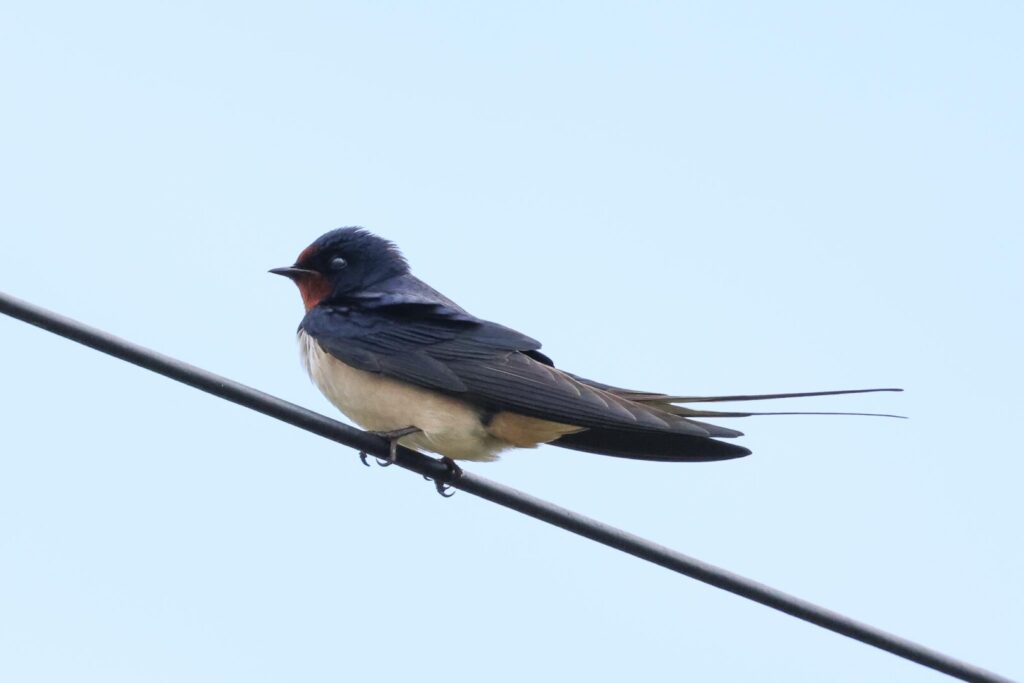
The cloud had seemed to be breaking up at Snettisham and the sun even appeared briefly, but as we drove round the coast to Holme it clouded over again and we drove into a light shower. It had stopped by the time we arrived at The Firs and checked in at the Visitor Centre, but we had to wait for another shower to blow over before we set off into the dunes.
Our main target here was Ring Ouzel – there had been several in the dunes here in recent days, stopping off on their way north from spending the winter in the Atlas Mountains, heading up to Scandinavia for the summer and probably waiting for a shift in the northerly wind. We didn’t have to go far before one flew up from one of the paddocks behind a low bank, followed by another two. They disappeared into some trees at first, but shortly after flew back out and landed on some low bushes in the grass in front of us.
There were at least a couple of male Ring Ouzels here, with more strongly marked white gorgets, and two duller, browner females. Someone was working in the back of the paddocks and had probably flushed them from where they were feeding as we watched them flying to and fro from the trees several times before they finally flew back and dropped into the short grass below the bank. We counted at least five now.
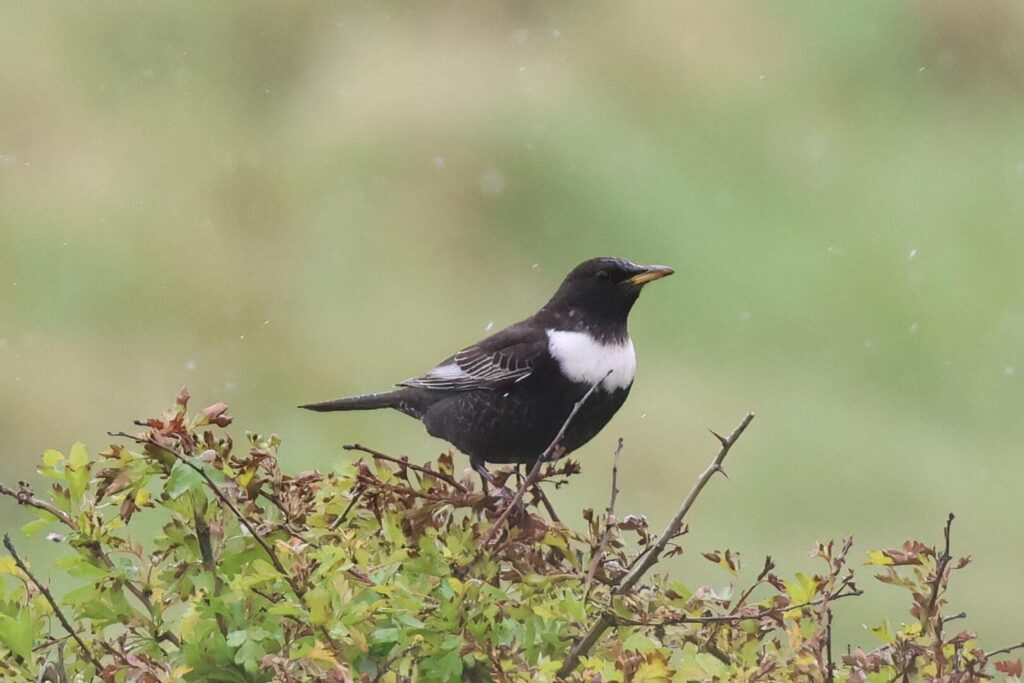
We continued on through the dunes to see if we could find any more migrants but it was rather too cold and the northerly wind was picking up. A lone Whimbrel flew over and a couple of Swallows flew past. There were more Lesser Whitethroats and a single Common Whitethroat in the bushes and we did find a single lemon yellow Willow Warbler trying to feed on the top of the dunes. The sea looked rather rough and there was no sign of anything moving offshore, so we came back through the middle where it was more sheltered. A Great White Egret flew over the marshes beyond the track and a couple of Marsh Harriers flew up and down.
There were lots of Linnets and Meadow Pipits feeding on the short grass and another Stonechat. The Ring Ouzels were now feeding in the longer grass, where they were harder to see, so we carried on back to The Firs. The rain had stopped now and it had brightened up a little again, so we were able to sit outside and eat our lunch on the picnic tables and enjoy a welcome hot drink.
There were a few ducks on Broadwater behind us, Common Pochard and Tufted Ducks, so afterwards we walked over to the bench overlooking the water for a closer look. We were rewarded with a Common Sandpiper feeding along the far edge, another spring migrant, as well as a brief late lingering drake Wigeon on the grass the other side. A Reed Warbler was singing from somewhere down in the reeds in front of us and a Blackcap was singing in the trees.
We continued our journey back west now and stopped again at Thornham Harbour. As we climbed up onto the seawall, five Cattle Egrets were flushed from where they were feeding around the cows by a Common Buzzard which drifted over. We watched them circle round a couple of times, before dropping back down with the cattle.
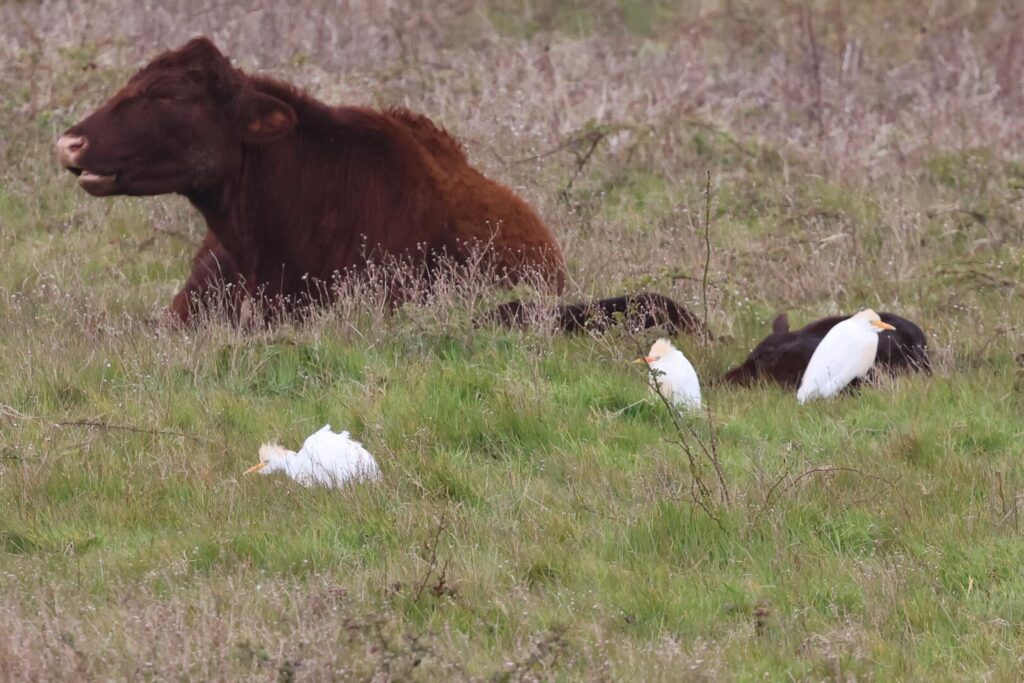
A group of very smart rusty breeding plumage Icelandic Black-tailed Godwits were feeding busily on the grass below the bank and there were a few more, along with three Teal on the first flash just beyond, but no sign of any Garganey. We walked to the far side, where we could scan with our backs to the wind, and we did spot five Whimbrel which dropped down into the field back before the cows where we got them in the scope, admiring their humbug-striped heads.
Continuing on to the pools further on, two Wheatears flicked along the bank ahead of us, a male with black bandit mask and a browner female, landing on the fence below and then flying out to the grass as a dog walker came the other way. We found a few male Ruff around the edges of the water, also starting to moult into breeding plumage and no two the same colour, plus several Common Snipe, and a couple of Little Ringed Plovers and a pair of White Wagtails on a more open patch of mud. There were lots of hirundines hawking low over the water, trying to find insects – mainly Swallows, with a couple of House Martins and Sand Martins with them.
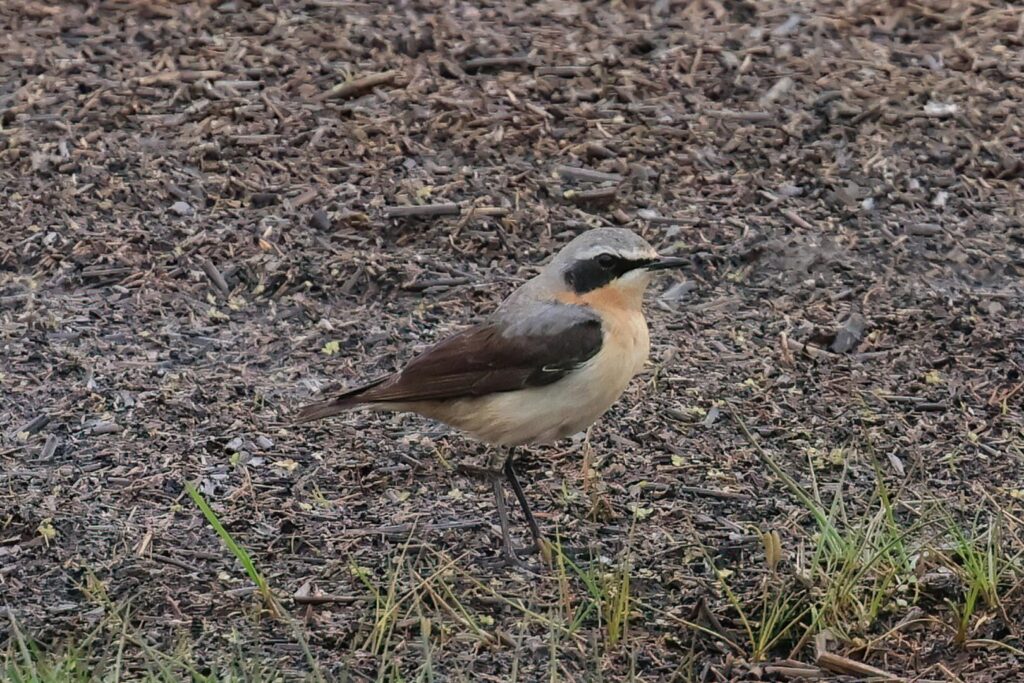
There were more Teal on the pools, but it took a bit of time to find the drake Garganey, before it finally woke up and came out of the grass where it had been hiding. We had a nice view of it now, feeding around the edge of one of the further pool, and then we noticed it had been joined by a female Garganey too. A Yellow Wagtail flew past and landed in the grass nearby, a very smart canary-yellow male, another spring migrant.
There was a great selection of birds here but it was feeling distinctly cold in the now very blustery north wind. We decided to head back to the warmth of the minibus and drove round to Titchwell for our last stop of the day. It was fairly sheltered in the car park and walking through the trees, before we were back out into the wind. Another Sedge Warbler was singing in the reeds and a few more Common Pochard and Tufted Ducks were on the reedbed pool together with a single Little Grebe.
We pressed on to Island Hide where we could get a bit of shelter to scan the Freshmarsh. The new islands have largely been taken over by Black-headed Gulls, lots of them. Looking through carefully we eventually found a pair of Mediterranean Gulls on one of the nearer islands, so we could get a good look at them through the scope – black hoods, white eye-liner, heavier bright red bill and pure white wing tips.
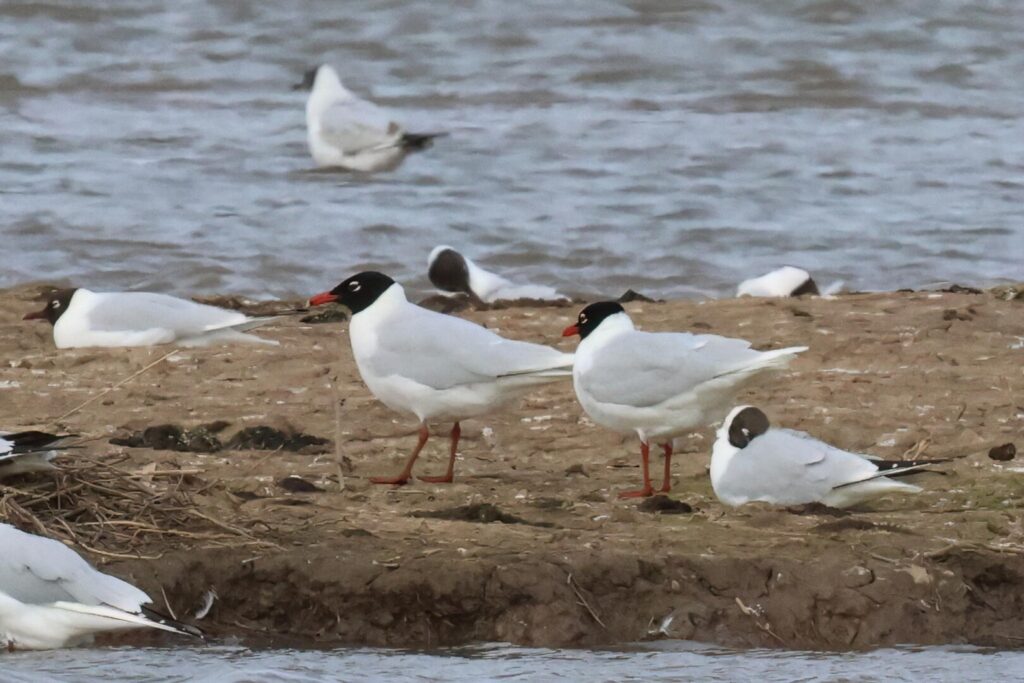
There were a few Avocets feeding in the deep water in front of the hide and a single Black-tailed Godwit and we could see a single Ringed Plover on the exposed mud on the next compartment over. A large flock of Brent Geese flew in and landed in the water right over the back, in front of the east bank – they will leave us much later than the other winter geese, in late May or even early June. We watched a pair of Bearded Tits feeding low down in the reeds on the edge of the water before the female flew off with a bill full of insects, presumably to feed a nest full of young out in the reedbed.
Back out on the main path, we stopped at the next compartment. A Little Ringed Plover was feeding on the mud right below the bank and we had a good view of its golden yellow eye-ring. There were a couple of Dunlin here too now and a single female Ruff, also traditionally known as a ‘Reeve’ and noticeably smaller then the males.

We were running out of time, but we decided to have a quick walk out to the beach, particularly to see if we could see any terns. A single Spoonbill flew across over the Volunteer Marsh as we passed, over the path and disappeared off out over the saltmarsh. There were no birds on the muddy channel today so we continued out past the Tidal Pools where there were more Black-tailed Godwits and Avocets feeding, and a small group of Oystercatchers roosting further back.
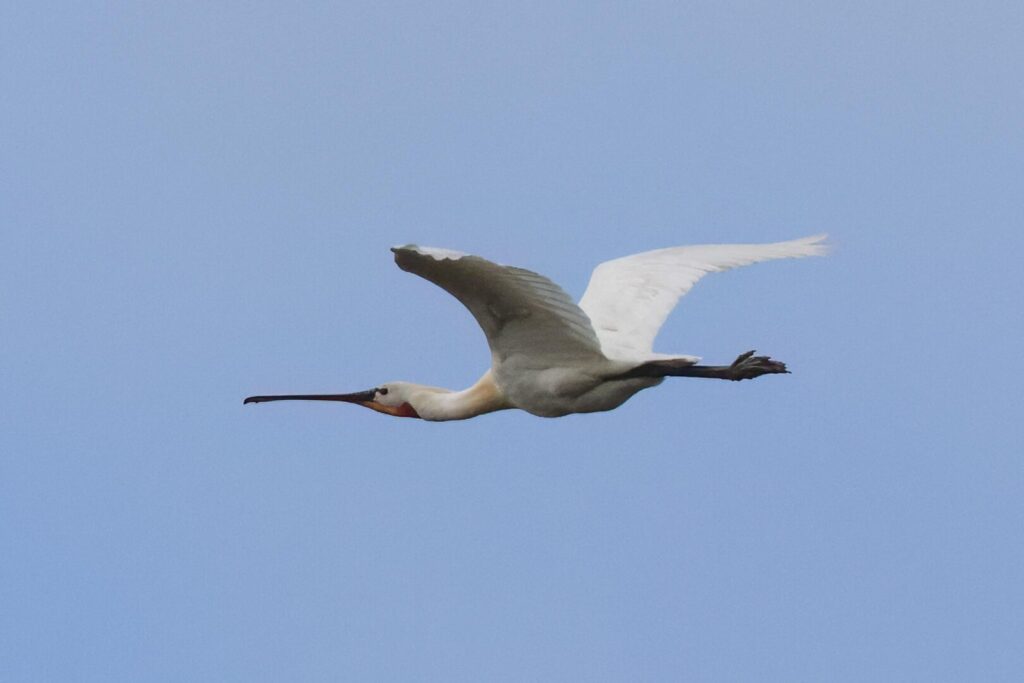
Out at the beach, the sea was rather rough and the tide was coming in. A Fulmar flew past offshore and we did spot a couple of distant Sandwich Terns too. We could just make out the Sandwich Tern colony away to the east on Scolt Head. We picked up a small raft of Common Scoter on the sea and got them in the scope – they kept disappearing in the swell but it was possible to see them as they rode over the waves. Out on the beach towards Brancaster, we could see several more Oystercatchers and we found a few silvery grey Sanderling running in and out of the waves in between them.
We turned to head back, a brisk walk to warm up, our backs to the wind now. Back at the Freshmarsh, we stopped briefly to talk to one of the reserve staff who had come out for a post-work walk. As we did, we scanned out over the water again and noticed a large bird in the distance, out over the saltmarsh towards Brancaster. An Osprey! As we watched, it flew slowly towards us, mobbed by a Herring Gull. It stopped to circle over the Freshmarsh, scattering all the gulls below, then continued its way west and over the path between us and the Visitor Centre, where its stopped and started to circle again, rapidly gaining height. A Sparrowhawk and a Marsh Harrier appeared over the Thornham grazing marsh too.
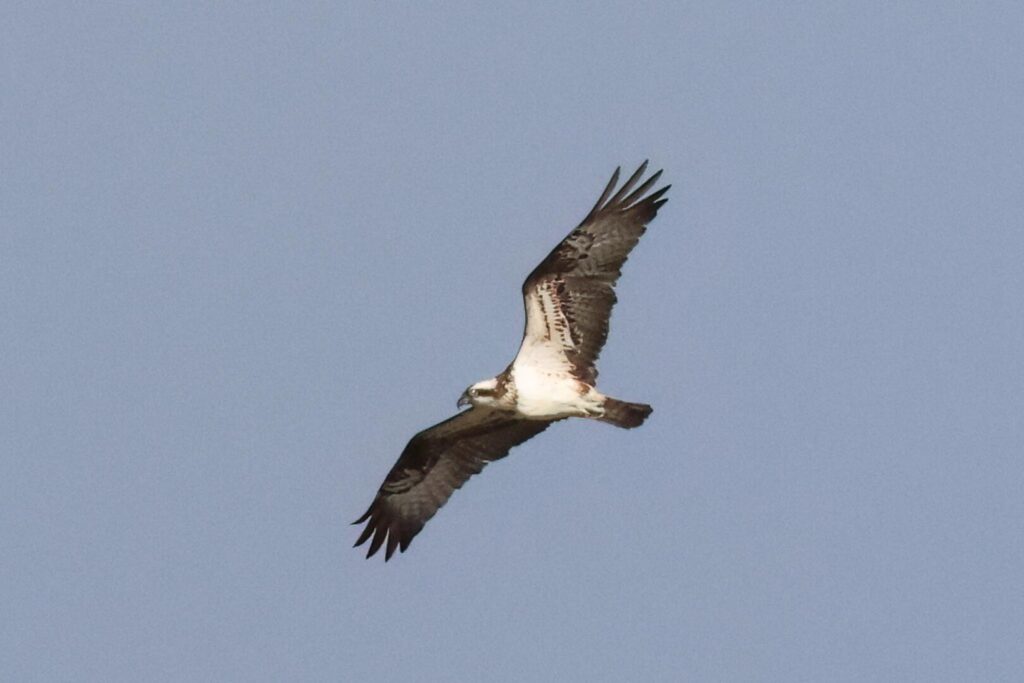
The Osprey is another passage migrant here. It had been seen earlier in the afternoon, flying over Cley and then past Stiffkey, but as it hadn’t got to us at the time we assumed it had stopped off or turned and headed inland. It was therefore a very nice surprise to see it now – and a great way to finish off our day of Spring Migration on the Norfolk coast.
















